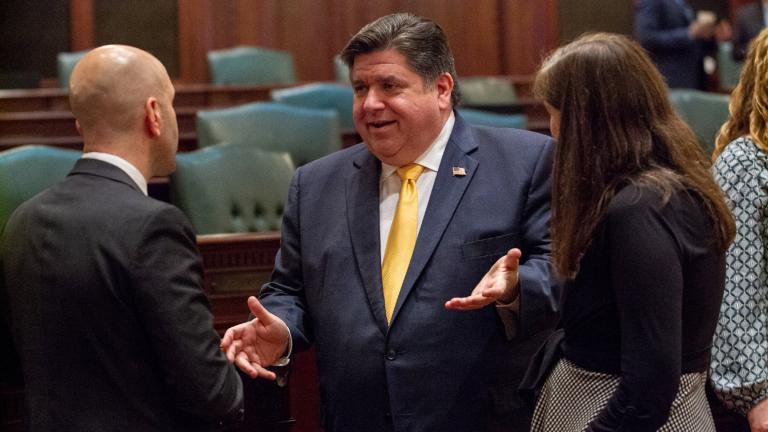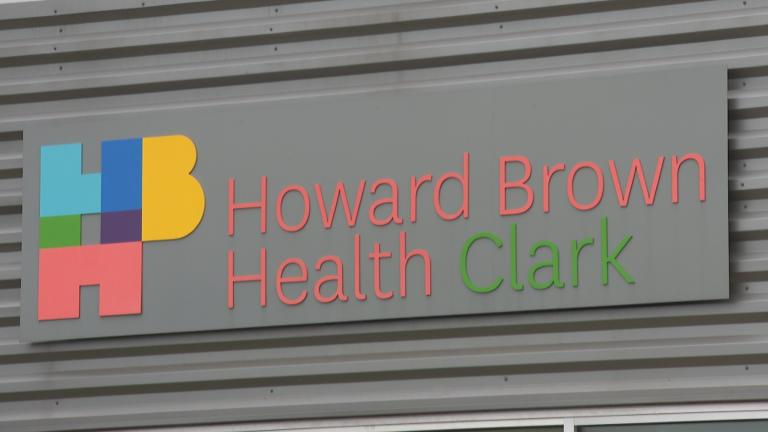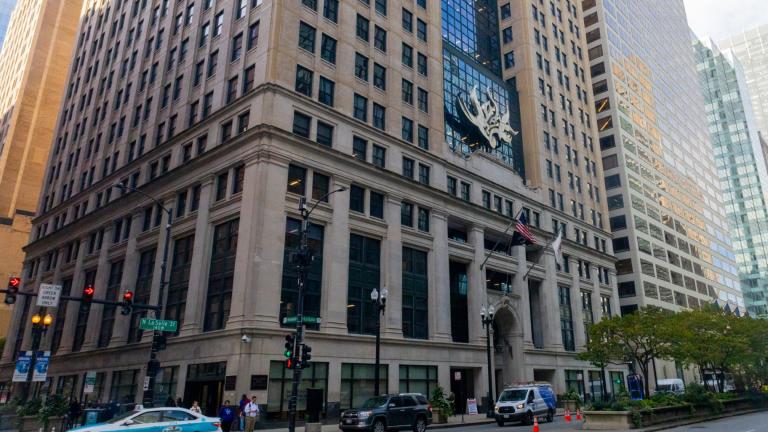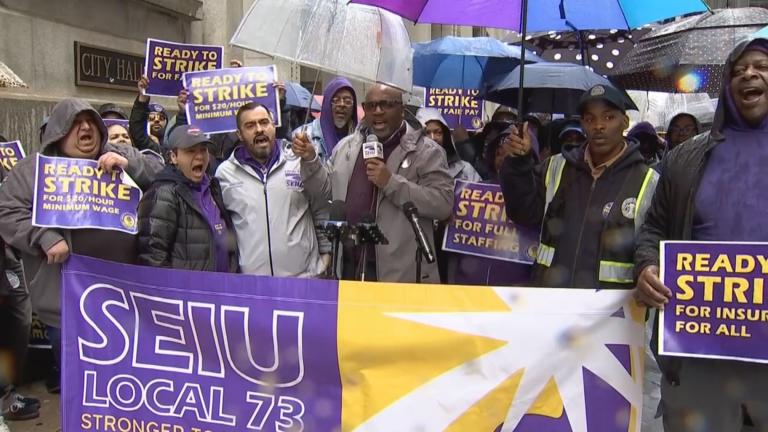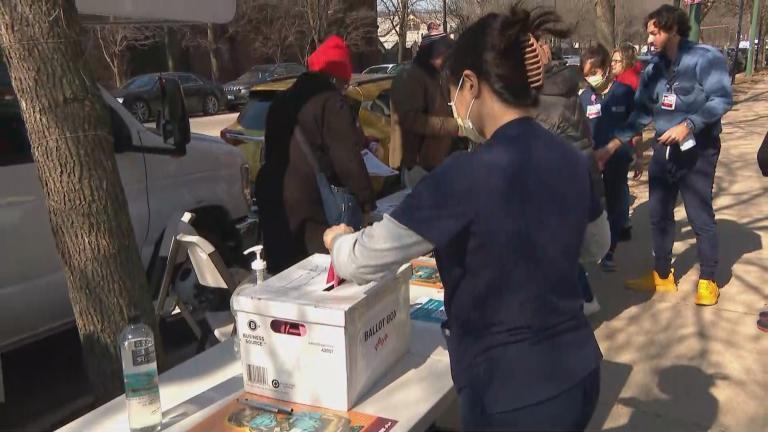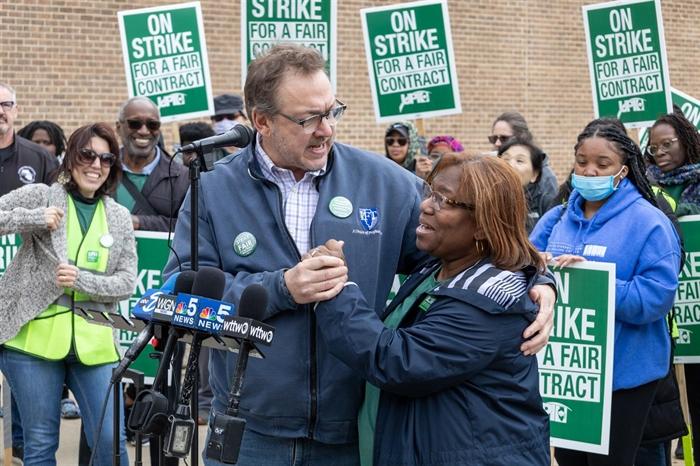 Valerie Goss, the head of the faculty union at Chicago State University, and Illinois Federation of Teachers President Daniel Montgomery embrace at an April 3, 2023, rally on the campus of Chicago State University. (Andrew Adams / Capitol News Illinois)
Valerie Goss, the head of the faculty union at Chicago State University, and Illinois Federation of Teachers President Daniel Montgomery embrace at an April 3, 2023, rally on the campus of Chicago State University. (Andrew Adams / Capitol News Illinois)
At public universities across the state, staff and faculty unions have faced a contentious year of negotiations and, in some cases, strikes.
Pay has been a major issue on several campuses and the unions are now looking to Springfield for potential reforms to the state’s higher education funding.
At Southern Illinois University Edwardsville, negotiations are ongoing between campus leadership and the union that represents clerical workers.
Amy Bodenstab, who works as an office manager in the Department of Teaching and Learning, also picks up weekend shifts at a local domestic violence shelter and contract work in data analytics to make ends meet.
She is on the bargaining team of AFSCME Local 2887, which has been without a contract since June 2022. She said the low pay and perceived lack of respect has resulted in high turnover rates, hampering university staff’s ability to do their jobs. She said it’s especially troubling because of the complexity of the positions her union represents, which can involve financial management, purchasing, scheduling and more.
“If you’re staff, you’re treated as ‘less than,’” Bodenstab told Capitol News Illinois.
Nicole Franklin, a spokesperson for the university, declined to comment specifically on the ongoing negotiations but said the university “continues to bargain in good faith” with the union.
But Bodenstab’s experience is echoed on other campuses around Illinois.
In mid-November, dozens of building services, clerical and culinary staff at Eastern Illinois University held an “informational picket” as negotiations continued between the local union and administrators at the Charleston campus.
“The number one issue is pay,” Kim Pope, an office manager and the head of the local union, said.
Negotiations between the building services workers at Northern Illinois University are also ongoing. The head of the union there, Patrick Sheridan, also said pay is the focus of negotiations.
Research published this fall by the Illinois Economic policy Institute, a think tank with strong ties to organized labor, found that pay for staff at state universities is 21% less than the rate paid to employees at state agencies who are performing the same or similar work.
When controlling for hours worked, occupation and several demographic factors, the research found the average staff pay at state universities is 14% less than at state agencies.
Robert Bruno, a University of Illinois professor in the School of Labor and Employment Relations and lead author of that report, said these trends made him consider the impact on staff morale.
“You worry about turnover, about positions not being filled, about if people don’t feel regarded or respected,” Bruno said.
He also noted these trends could be explained by an ongoing trend in higher education.
“It starts to look like a more for-profit model,” he said. “Part of that is a lack of support at the state level.”
That research and recent university staff negotiations have led union organizations to begin planning a bigger request to the state in next year’s budget talks – an ask that could prove challenging as early estimates from Gov. J.B. Pritzker’s budgeting office project a revenue shortfall for the upcoming fiscal year.
“We’ll be pushing for an appropriation that can be earmarked for wages,” Anders Lindall, a spokesperson for the statewide AFSCME organization, said.
He specifically pointed to Bruno’s research as part of the reasoning for this push.
“We’re going to be talking to legislators about these systemic pay gaps,” he said.
AFSCME is one of the most powerful lobbying organizations in Illinois. In the 2022 election cycle, AFSCME, through its state council and national organization, spent $2.6 million on campaign contributions and expenditures around the state. That includes over $300,000 each in contributions to House Speaker Emanuel “Chris” Welch, D-Hillside, and Senate President Don Harmon, D-Oak Park.
In addition to staff negotiations, the past 12 months have seen a wave of strikes led by faculty unions. In January, faculty at the University of Illinois Chicago struck for five days.
In April, faculty at Chicago State University, Governors State University and Eastern Illinois University all went on overlapping strikes, lasting between five and 13 days. Northeastern Illinois University authorized a strike, although the faculty union there never formally struck.
In private higher ed, Columbia College Chicago faculty also went on an unusually long strike which lasted all of November and ended in mid-December.
Dan Montgomery, head of the Illinois Federation of Teachers, said after the Columbia strike ended that he had “never seen anything like it in any other year.”
“We’re a strong labor state. I think those trends you’re seeing play out in Illinois are playing out around the country,” Montgomery told Capitol News Illinois. “We’re just better organized.”
Montgomery said he is “cautiously optimistic” that a new funding model being developed by the Commission on Equitable Public University Funding could help alleviate some of the problems that led to the strikes.
The commission, which was created by the General Assembly in 2021, is tasked with developing a new model for funding higher education. The legislature charged the commission with “remediating inequities” in the higher education system that have led to disparities in access for underrepresented students such as Black and Hispanic students and those who come from low-income families.
The commission’s work is ongoing but was delayed by this summer’s U.S. Supreme Court decision about affirmative action and race in higher education. While the commission’s work is likely not going to impact next year's budget, it could create a drastic shift in the long term.
The model being developed will be similar to the funding formula used for K-12 schools in Illinois, which was rolled out in 2017. The K-12 model calls for an added $350 million in funding each year and sets a funding adequacy target for each district. It then directs greater portions of the new funding to the schools furthest from their adequacy target.
While the commission has not finalized a formula, some draft meeting materials presented at the board’s November meeting suggest it would require as much as an overall $14,000 per-student increase in state appropriations to fully fund higher education. With 130,000 undergraduates and 56,000 graduate students enrolled at state universities this year, these numbers suggest the needed funding increase could reach into the billions.
Lawmakers allocated about $4.5 billion from the state’s general revenue fund to higher education in the current fiscal year.
Any recommendations from the commission, however, would need to be approved by the General Assembly, leaving room for doubt when it comes to fully implementing – and funding – the commission’s recommendations.
“The problem is always the problem: finding the funds to do it,” Montgomery said.
The state revenue landscape could further compound the challenge. The Governor’s Office of Management and Budget is projecting an $891 million deficit for the upcoming fiscal year 2025, although that number drops to $721 million when accounting for the statutory contribution to the state’s “rainy day” savings fund.
“I think it's a signal that everybody, we need to be careful in Illinois, we have to balance our budget…” Pritzker told Capitol News Illinois when asked about the projection earlier this month. “And so, if that requires us to reduce the increases that may occur in certain programs, maybe that will be necessary.”
Capitol News Illinois is a nonprofit, nonpartisan news service covering state government. It is distributed to hundreds of print and broadcast outlets statewide. It is funded primarily by the Illinois Press Foundation and the Robert R. McCormick Foundation, along with major contributions from the Illinois Broadcasters Foundation and Southern Illinois Editorial Association.

